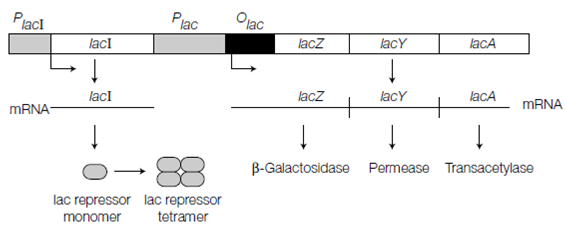lac Operon:
The lac operon one of the major studied operons is the lac operon in the E. coli. This codes for key enzymes included in lactose metabolism: -galactosidase which hydrolyzes lactose to glucose and galactose and galactoside permease which is also known as lactose permease; it transports lactose into the cell across the cell membrane. It also codes for a third enzyme thiogalactoside transacetylase. Generally E. coli cells make very little of any of these three proteins but when lactose is available it causes a huge and coordinated rise in the amount of every enzyme. Therefore every enzyme is an inducible enzyme and the procedure is known induction. The mechanism is in which the few molecules of -galactosidase in the cell before induction convert the lactose to allolactose that then turns on transcription of these three genes in the lac operon. Therefore allolactose is an inducer. Another inducer of the lac operon is IPTG (isopropylthiogalactoside). Unlike allolactose, this inducer is not metabolized through E. coli and so is useful for experimental learning of induction.
In the lac operon that is shown in the figure, the structural genes are the lacY lacZ, and lacA genes encoding -galactosidase the permease and the transacetylase respectively. That are transcribed to yield a single polycistronic mRNA which is then translated to produce all three enzymes. An existence of a polycistronic mRNA ensures which the amounts of all three gene products are regulated coordinately. The Transcription occurs from a single promoter (Plac) that lies upstream of these structural genes and binds RNA polymerase. Moreover, also present are an operator site (Olac) among the promoter and the structural genes and a lacI gene which codes for the lac repressor protein.

Figure: Structure of the lac operon.